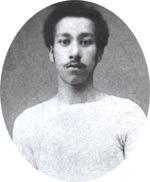First
Black footballer, Andrew Watson, inspired British soccer
in 1870s
A worn photograph, some yellowing newspaper files, a cryptic
comment and a brief mention in a dusty census tome have
been unearthed in Scotland in what has been described as
the most important discovery in the history of Black footballers
in Britain, the Chronicle has learned.

Andrew Watson of Queens ParkFC, Glasgow, circa 1879, courtesy
of the Scottish Museum
"We believe the findings, dated between the 1870s
and 1880s, could prove that the first black British footballer
was Andrew Watson who played for Queens Park (Glasgow)
and Scotland, said Ged O'Brien, director of the Scottish
Football Museum and leading member of the Association of
Sports Historians.
Born May 1857 in British Guiana, Andrew Watson lived and
sired a family in Scotland and came to be known as one
of the best players in the whole of Britain.
Details of the discovery read like pages from an archaeological
adventure. Researchers sifting through old football programs
and memorabilia noted the adolescent face and distinctive
features of one Queens Park player and decided to investigate
who he was. They combed through the pages of the Scottish
Internationalist and the Who's Who 1872-1986. But after
5 years they still had no proper clues to the youth's elusive
identity, said O'Brien.
But, scanning the recently digitalised 1881 census data
put the researchers on the right track. The entry shows
that an Andrew Watson, aged 24, lived with his wife and
child at Afton Crescent in Govan. Newspaper interviews
and articles of the day gave further clues. Photographs
of Watson in the colours of the Queens Park Football Club,
the most elite and famous amateur football club of the
day, confirmed the discovery. "Our eyes were opened
to a wider vision of Watson the man, the Scottish and international
player, and club secretary, " says O'Brien.
In an exclusive interview with the Chronicle, Mr O'Brien
revealed that Watson started his career with Maxwell FC
in Glasgow. His next stop was Parkgrove in 1874. Then came
the halcyon days of glory at Queens Park from 1880 to 1887.
According to Scottish football researchers, Watson was "no
mere scuffler on the field"; he was a respected player
and team supporter.
Mr O'Brien said that Watson roamed far afield to play
the game, as was common in those days, He was much sought
after by clubs in England as well as Scotland. Records
show he played in 36 competitive games for Queens Park.
He also appeared for the London Swifts in the English Cup
championships 1882, making him the first Black player in
English Cup history.
Commentators of the day regarded Watson "as one of
the best players in Britain". He earned 2 Scottish
Cup medals and 4 Charity Cup medals during his career;
the Who's Who acknowledged his performances in international
matches.
Watson's place in football history extends to the highest
echelons of the game. As Club Secretary for Queens Park
- the man who arranged the team schedule and managed its
affairs - Watson was first Black in a British club's boardroom.
He helped build up the profile of his club and prestigious
tournaments, and ensured the loyalty of future generations
of fans and spectators.
Watson's stellar attributes marked him as special for
his times.(The Football Association, the game's governing
council, was formed in 1863 and professionalism was legalised
in 1885). Undoubtedly, Watson was there at the birth of
organised football out of its "aimless, chaotic",
often violent, roots in workingmen's culture. No mean feat
for a first generation immigrant in a game where nonwhites
were rare, and in a city like Glasgow where African Caribbeans
were nearly invisible.
Though much more investigation is needed, a few tentative
conclusions can be drawn. The discovery could lead to a
fundamental reappraisal of Black history in football, said
Mr O'Brien. It can provide the impetus for further research
into football as a proper area of academic study.
 Without doubt, sports observers will have to update their
records. Prime examples include Paul Vasili, author of
Colouring Over the White Line: The History of Black Footballers
in Britain (Mainstream 2002) and Al Hamilton and Rodney
Hinds writing in Black Pearls: The A-Z of Black Footballers
in the English Game (Hansib 1999). The authors mistakenly
cite as "firsts" Arthur Wharton, born in Ghana,
who joined Preston North End in the late 1880s, and Walter
Tull, of Barbadian descent, who played for the north London
club Tottenham Hotspurs in the early 20th century. Without doubt, sports observers will have to update their
records. Prime examples include Paul Vasili, author of
Colouring Over the White Line: The History of Black Footballers
in Britain (Mainstream 2002) and Al Hamilton and Rodney
Hinds writing in Black Pearls: The A-Z of Black Footballers
in the English Game (Hansib 1999). The authors mistakenly
cite as "firsts" Arthur Wharton, born in Ghana,
who joined Preston North End in the late 1880s, and Walter
Tull, of Barbadian descent, who played for the north London
club Tottenham Hotspurs in the early 20th century.
The Watson discovery will also stimulate a radical rethink
of prejudices about Black footballers' abilities, on and
off the field. Andrew Watson, as a player and club administrator,
put Scottish and British soccer on the world map. He pioneered
a narrative of Black progress in British football that
can be regularly tapped for inspiration.

Mistakenly cited as a "first" Arthur
Wharton
"Watson was a man of intelligence, foresight and
entrepreneurial skills" said Mr O'Brien. Rescuing
him from obscurity is one of the most exciting and important
events in what remains a murky field of British football
history.
What do you know of Andrew Watson? The Scottish Museum
welcomes assistance in its continuing research, especially
from readers in India and Guyana South America. Director
Ged O'Brien can be contacted at: [email protected]
© Copyright 1997-2005 Chronicle World -
first published 30/07/02
We thank http://www.chronicleworld.org for
the use of this article from their archive. Visit their
site!
|




